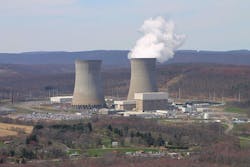AWS Acquiring Hyperscale Data Center Directly Connected to Nuclear Plant
Amazon Web Services (AWS) is acquiring a 960-MW data center campus in Pennsylvania which will be directly powered with nearby nuclear energy.
Talen Energy, which owns both the Cumulus data center project as well as the Susquehanna nuclear power plant, agreed to sell the facility to AWS for approximately $650 million, according to reports. The deal also includes a provision in which Talen will receive additional revenue from AWS related to the dispatch of carbon-free power back into the grid.
Cloud data service provider AWS will install its hyperscale data center at the site. Talen will supply direct-connect nuclear power from its Susquehanna power plant to the future AWS campus under a long-term power purchase agreement.
“This transaction provides an attractive return on Talen’s investment and vision in building Cumulus, and creates value through the sale of clean carbon-free power from the our Susquehanna nuclear plant,” Talen Energy CEO Mac McFarland said in a statement.
The project does have some opposition from the utility sector. AEP and Exelon , on behalf of their subsidiary utilities, filed protests with the Federal Energy Regulatory Commission in June 2024, alleging that some $140 million in transmission costs will be borne by customers while AWS gets the benefits.
Domestic nuclear energy, generated from more than 90 utility-scale plants in the U.S., provides close to 20% of the nation’s electricity resources and more than half of its carbon-free power, according to the federal Energy Information Administration.
Susquehanna, located in Luzerne County, Pennsylvania, can generate close to 2.5 GW of power capacity through its two units. The first unit went online in 1983 and unit 2 was commissioned two years later.
Utility company PPL owned and operated Susquehanna until June 2015 when Talen Energy was formed out of PPL’s competitive supply business to take that business over. The plant has two General Electric boiling water reactors.
Talen subsidiary Cumulus Data was formed to begin developing and building the hyperscale center to attract a tenant or buyer. The 1,200-acre campus facility completed several construction milestones over the past year.
The boom in artificial intelligence capacity will add to the energy demand as more hyperscale data centers are being planned. Synergy Research Group has forecasted that hyperscale data center capacity will nearly triple over the next five years.
Data center firms, meanwhile, are focused on emissions reduction goals and seeking carbon-free microgrid-type energy connections such as renewable natural gas, solar and storage, and nuclear. In fact, Microsoft announced it is hiring for a new job to seek potential connection of its data centers to advanced and small modular reactor (SMR) nuclear technologies.
“This senior position is tasked with leading the technical assessment for the integration of SMRs and microreactors to power the data centers the Microsoft Cloud and AI reside on,” read a company release in announcing the job and future focus on small nuclear.
Studies by Xendee, the Idaho National Laboratory and others are exploring the potential for microgrids of the future to utilize SMR nuclear, although many industry insiders are skeptical of the idea due to safety, location and cost concerns.
Nuclear and Hydrogen: Microgrids Beyond Carbon and Renewables
Upcoming Session at Microgrid Conference 2024
Happening April 22-24 in Baltimore: Early Bird Registration Still Available
The SMR industry also suffered a recent blow when reactor designer Nuclear Power and electric cooperative Utah Associated Municipal Power Systems terminated the planned Carbon Free Power Project pilot in Idaho. The NuScale small reactor design had gained federal approval, but a shortfall in subscriptions from potential off-takers made the project uneconomical.
Nonetheless, small nuclear technology firms like X-energy, NuScale and others are pursuing future goals to build the projects. Proponents say nuclear energy is currently the only carbon-free energy resource that can produce at a higher efficiency and capacity factor than renewables such as solar, wind and battery storage.
Others dispute that contention and say that over the long haul solar and other renewables are better at truly reducing greenhouse gas emissions.









